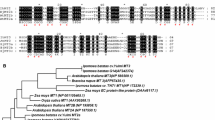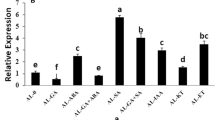Abstract
The PsMT gene family of pea (Pisum sativum L.) encodes predicted proteins with sequence similarity to metallothioneins. However, PsMT proteins have not yet been characterised in planta and their functions remain obscure. PsMT transcripts were identified in the cortex tissue of pea roots using tissue squash-blotting techniques. Transcripts were not detected on northern blots of RNA isolated from the embryonic radicle, but PsMT transcript abundance in roots increased with age of germinating seedlings. The PsMT A gene was expressed in E. coli as a carboxyterminal extension of glutathione-S-transferase (GST). Fusion protein purified from crude cell lysates (500 mL cultures) bound an estimated amount of 5.99, 6.27 and 7.07 moles of Zn, Cu and Cd respectively per mole protein, compared to equivalent estimates of 0.37, 0.63 and 0.26 moles for GST alone. Similar estimates for Fe-binding were 0.28 moles for GST-PsMT A fusion protein and 0.1 moles for GST alone.
In summary, these data: 1, show that PsMT transcripts are abundant in roots of pea plants that have not been exposed to supra-optimal concentrations of trace metals and hence appear to be constitutively expressed and 2, indicate that PsMT A protein can bind certain trace metal ions. We have also identified and partially purified a Zn ligand (Zn-A) and two Cu ligands (Cu-A, Cu-B) from pea roots which have not been exposed to supra-optimal conditions of trace metal ions and are therefore defined as ‘constitutive’. Whether or not these ligands include the products of PsMT genes remains to be established.
Similar content being viewed by others

References
Delhaize E, Jackson P J, Lujan L D and Robinson N J 1989 Poly(γ-glutamylcysteinyl)glycine synthesis and aggregation with cadmium: Role in cadmium-tolerance. Plant Physiol. 89, 700–706.
Evans I M, Swinhoe R, Gatehouse L N, Gatehouse J A and Boulter D 1988 Distribution of root mRNA species in other vegetative organs of pea (Pisum sativum L.). Mol. Gen Genet. 214, 153–157.
Evans I M, Gatehouse L N, Gatehouse J A, Robinson N J and Croy R R D C 1990 A gene from pea (Pisum sativum L.) with homology to metallothionein genes. FEBS Lett. 262, 29–32.
Feinberg A P and Vogelstein B 1983 A technique for radiolabelling DNA restriction endonuclease fragments to high specific activity. Anal. Biochem. 132, 6–13.
Grill E, Winnaker E L and Zenk M H 1985 Phytochelatins: The principal heavy-metal complexing peptide of higher plants. Science 230, 574–576.
Grill E, Winnaker E-L, and Zenk M H 1987 Phytochelatins, a class of heavy-metal binding peptides from plants, are functionally analogous to metallothioneins. Proc. Natn. Acad. Sci. 84, 439–443.
Grusak M A, Welch R M and Kochian L V 1990 Physiological characterization of single-gene mutation of Pisum sativum exhibiting excess iron accumulation. Plant Physiol. 93, 976–981.
Hanley-Bowdoin L and Lane B G 1983 A novel protein programmed by the mRNA conserved in dry wheat embryos: The principal site of cysteine incorporation during early germination. Eur. J. Biochem 135, 9–15.
Jackson P J, Unkefer C J, Doolen J A, Watt K and Robinson N J 1987 Poly(γ-glutamylcysteinyl)glycine: Its role in cadmium resistance in plant cells. Proc. Natn. Acad. Sci. 84, 6619–6623.
Kägi J H R and Kojima Y 1987 Chemistry and Biochemistry of metallothionein. In Metallothionein II. Eds. J H R Kägi and Y Kojima. pp 63–80. Birkhäuser Verlag, Basel-Boston.
Kägi J H R and Schäffer A 1988 Biochemistry of metallothionein. Biochemistry 27, 8509–8515.
Kawashima I, Inokuchi Y, Chino M, Kimura M and Shimizu N 1991 Isolation of a gene for a metallothionein-like protein from soybean. Plant Cell Physiol. 32, 913–916.
Kondo N, Isobe M, Imai K and Goto T 1985 Synthesis of metallothionein-like peptides cadystin A and B occurring in fission yeast, and their isomers. Agric Biol. Chem. 49, 71–83.
Lane B, Kajioka R and Kennedy T 1987 The wheat germ Ec protein is a zinc-containing metallothionein Biochem. Cell Biol. 65, 1001–1005.
McMasters G K and Carmichael G G 1977 Analysis of single-stranded and double-stranded nucleic acids on polyacrylamide and agarose gels by using glyoxal and acridine orange. Proc. Natn. Acad. Sci. 74, 4835–4838.
deFramond A J 1991 A metallothionein-like gene from maize (Zea mays) Cloning and characterization. FEBS Lett. 290, 103–106.
deMiranda J R, Thomas M A, Thurman D A and Tomsett A B 1990 Class I metallothionein genes from the flowering plant Mimulus guttatus. FEBS Lett. 260, 277–280.
Okumura N, Nishizawa N-K, Umehara Y and Mori S 1991 An iron deficiency-specific cDNA from barley roots having two homologous cysteine-rich MT domains. Plant Molec. Biol. 17, 531–533.
Palmiter R D 1987 Molecular biology of metallothionein gene expression. In Metallothionein II. Eds. J H R Kägi and Y Kojima. pp 63–80. Birkhäuser Verlag, Basel-Boston.
Pressler U, Staudenmaier H, Zimmermann L and Braun V (1988) Genetics of the iron dicitrate transport system of Escherichia coli. J. Bacteriol. 170 2716–2724.
Rauser W E 1990 Phytochelatins. Annu. Rev. Biochem. 59, 61–86.
Robinson 1990 Metal-binding polypeptides in plants. In Heavy-metal tolerance in plants. Ed. A J Shaw. pp 195–214. CRC Press, Boca Raton FL.
Robinson N J, Gupta A, Fordham-Skelton A P, Croy R R D, Whitton B A and Huckle J W 1990 Prokaryotic metallothionein gene characterisation and expression: Chromosome crawling by ligation-mediated PCR. Proc. R. Soc. Lond. B. 242, 241–247.
Smith D B and Johnson K S 1988 Single-step purification of polypeptides expressed in Escherichia coli as fusions with glutathione-S-transferase. Gene 67, 31–40.
Steffens J C 1990 The heavy metal-binding peptides of plants. A. Rev. Pl. Physiol. Pl. Mol. Biol. 41, 553–575.
Tommey A M, Shi J, Lindsay W P, Urwin P E and Robinson N J 1991 Expression of the pea gene PsMT A in E. coli: Metal-binding properties of the expressed protein. FEBS Lett. 292, 48–52.
Tsujikawa K, Imai T, Katutani M, Kayamori Y, Mimura T, Otaki N, Kimura M, Fukuyama R and Shimizu N 1991 Localization of metallothionein in nuclei of growing primary cultured adult rat hepatocytes. FEBS Lett. 283, 239–242.
Author information
Authors and Affiliations
Rights and permissions
About this article
Cite this article
Robinson, N.J., Marta Evans, I., Mulcrone, J. et al. Genes with similarity to metallothionein genes and copper, zinc ligands in Pisum sativum L.. Plant Soil 146, 291–298 (1992). https://doi.org/10.1007/BF00012023
Issue Date:
DOI: https://doi.org/10.1007/BF00012023



